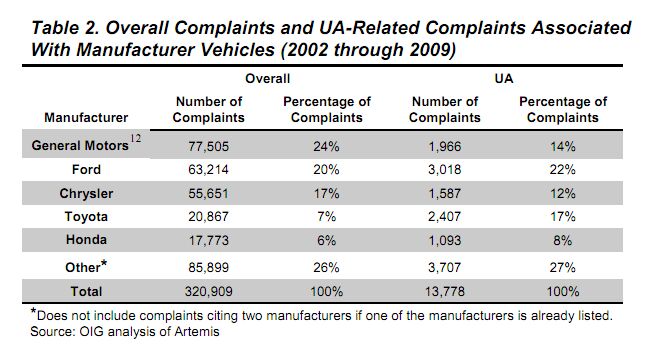Inspector General: NHTSA Needs To Rethink Defect Investigation
Remember the uproar over Unintended Acceleration in Toyotas? After more than a year of investigation, NHTSA has yet to find a definitive cause for the furor… although the experience was not an entire waste. In fact, the most interesting result of the entire situation was that it cast light on NHTSA’s inefficacy as much as it did embarrass Toyota’s quality control. And to help clarify what exactly the lessons of the Toyota flap were, the DOT’s Inspector General has released a report detailing its criticisms of the federal safety regulators. According to the report [ PDF], NHTSA’s Office of Defect Investigation (ODI) has not
- Adequately tracked or documented pre-investigation activities.
- Established a systematic process for determining when to involve third-party or Vehicle Research and Test Center (VRTC) assistance
- Followed timeliness goals for completing investigations or fully implemented its redaction policy to ensure consumers’ privacy. [Ed: gee, you think?]
- Established a complete and transparent record system with documented support for decisions that significantly affect its investigations.
- Developed a formal training program to ensure staff has the necessary skills and expertise.
In his response, NHTSA Administrator David Strickland largely concurred with the audit’s findings, and is working with the ODI to improve investigation processes, transparency, privacy controls, staffing, training and more. In short, the government has reached the same conclusion that I reached on the day of the angst-filled Toyota testimony before congress, to wit:
Congress holds hearings like these to uncover shocking evidence and to impress its constituents with its dedication to their safety and well-being. Having been enticed into believing that sinister conspiracies exist in Toyota’s software code and the halls of the NHTSA, the House Energy Committee uncovered only one actionable solution to the ongoing scandal: [improving] NHTSA’s investigative capabilities. Put differently, after hours of posturing congress finally met the enemy and he was them.
More by Edward Niedermeyer
Latest Car Reviews
Read moreLatest Product Reviews
Read moreRecent Comments
- GregLocock Not as my primary vehicle no, although like all the rich people who are currently subsidised by poor people, I'd buy one as a runabout for town.
- Jalop1991 is this anything like a cheap high end German car?
- HotRod Not me personally, but yes - lower prices will dramatically increase the EV's appeal.
- Slavuta "the price isn’t terrible by current EV standards, starting at $47,200"Not terrible for a new Toyota model. But for a Vietnamese no-name, this is terrible.
- Slavuta This is catch22 for me. I would take RAV4 for the powertrain alone. And I wouldn't take it for the same thing. Engines have history of issues and transmission shifts like glass. So, the advantage over hard-working 1.5 is lost.My answer is simple - CX5. This is Japan built, excellent car which has only one shortage - the trunk space.


































Comments
Join the conversation
I'm a Prius owner and I've also owned 2 Fords. I've personally experienced stuck gas pedals in both Fords, and I've experienced flawless performance from the Prius. Let me say that again: Ford: 2 Toyota: 0 Lower is better. No, data is not the plural of anecdote, but it does make me skeptical of the hype. Also, since I've had stuck gas pedals in 2 of the last 5 cars I've owned (or driven regularly as part of the family), I'd submit that learning how to deal with a stuck gas pedal is a skill that every driver should have. For the record, my Tempo had a binding throttle cable at somewhere around 140k miles. The stuck pedal in my Ranger was probably because it got tangled up in a floor mat. Both were manual transmission cars, so I just put in the clutch and dealt with the (rather noisy) problem while I was coasting. We've put about the same number of miles on the Prius as I have on those two Fords combined, and I'm not reluctant to shift the Prius into neutral, hit the "Park" switch, or turn the car "off" if I have to -- given my experience with the Fords, and the hype, I've done a few practice drills in the Prius and feel confident that I could deal with it competently.
To properly put UA in perspective, one needs to dig deeper, and use the approach favored by engineers when creating an FMEA, namely speaking in terms of severity, where severity is not a function of occurrence, or the ability to detect the existence of the fault during the manufacturing process. By taking each occurrence for each vehicle line, or cross-vehicle common sub-/system, and multiplying it by say, 10 for deaths, 8 for injuries, 6 for vehicular or property damage, 4 for a pants-filling near-miss, 2 for a lesser incident, these issues could be put into better context, better understood and acted on with a deliberate, rather than possibly extingent, priority.